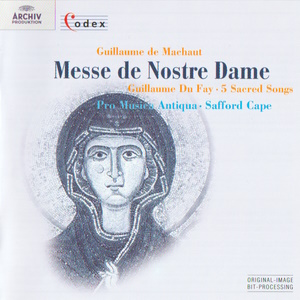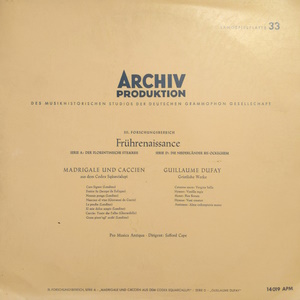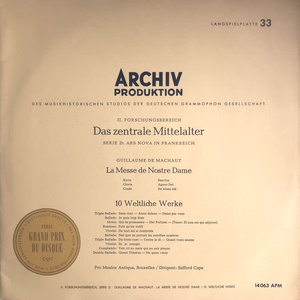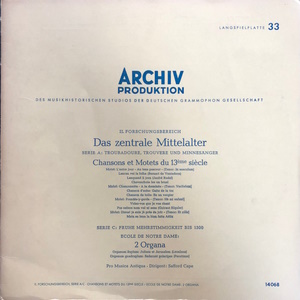 |
|
1 CD -
453 162-2 - (p) 1996
|
|
50
Jahre (1947-1997) - Codex I Serie - 1/10
|
|
|
|
|
|
|
|
|
| LÉONIN
(fl. 1160-1180) |
Judae et
Jerusalem - Organum duplum
|
Tenor,
Bass
|
|
7' 01" |
1
|
| PÉROTIN
(fl. 1180-1225) |
Sederunt
principes - Organum
quadrupulum
|
Tenor
(3), Bass
|
|
14' 56" |
2 |
| Guillaume De MACHAUT
(c. 1300-1377) |
Messe
de Nostre Dame |
Soprano,
Alto, Tenor (2), Bass, Recorder,
Treble Fiddle, Tenor Fiddle (2),
Lute
|
|
28' 44" |
|
|
-
Kyrie I · Christe · Kyrie II · Kyrie
III |
|
5' 23" |
|
3 |
|
-
Gloria |
|
5' 08" |
|
4 |
|
-
Credo |
|
7' 43" |
|
5 |
|
-
Sanctus
|
|
4' 48" |
|
6 |
|
-
Agnus Dei
|
|
4' 23" |
|
7 |
|
-
Ite missa est
|
|
1' 19" |
|
8 |
| Guillaume DU FAY
(c. 1397-1474) |
Vergine bella |
Alto,
Treble Fiddle, Tenor Fiddle (2)
|
|
5' 08" |
9 |
|
Vexilla
Regis
|
Alto,
Tenor, Bass |
|
3' 21" |
10 |
|
Flos
florum
|
Alto,
Treble Fiddle, Tenor Fiddle (2),
Tenor (2), Bass
|
|
4' 59" |
11 |
|
Veni creator
spiritus |
Alto,
Tenor (2) |
|
6' 29" |
12 |
|
Alma
redemptoris mater
|
Alto,
Treble Fiddle, Tenor Fiddle (2),
Tenor (2), Bass |
|
4' 28" |
13 |
|
|
|
|
PRO MUSICA ANTIQUA
/ Safford CAPE
- Elisabeth Verlooy 2), Soprano
- Jeanne Deroubaix 2), 3),
Alto
- René Letroye 1), Franz
Mertens, Frédéric Anspach
1), Louis Devos 3), Tenor
- Willy Pourtois 1),
2), Maurice de Groote 1), Albert
von Ackere 3), Bass
- Silva Devos 2), Recorder
- Janine Rubinlicht 2), Janine
Tryssesoone 3), Treble
Fiddle
- Gaston Dôme 2), André
Douvere 2), Arthur Dirkx
3), Fernand Terby 3), Tenor
Fiddle
- Michel Podolski 2), Lute
1) Léonin / 2) Pérotin / 3) Dufay
|
Instruments:
Recorder:
- Soprano recorder by Hermann Moeck,
Celle 1952
- Alto recorder by Franz Küng,
Schaffhausen 1953
- Tenor recorder by Gobel, Oxford 1950
Treble fiddle: after Pietro
aaron, Thoscanello de la musica,
1531. Reconstruction by von Otwin,
Hanover 1932
Tenor fiddle: after Francesco
Francia, Madonne tronante,
Reconstruction by von Otwin, Hanover
1932
Lute: Tenor lute by Peter
Harlan, Marltneukirchen 1930
|
|
|
|
|
Luogo
e data di registrazione |
|
Palais
des Académies, Brussels (Belgio) -
giugno 1653 (Du Fay)
Palais du Compte d'Egmont,
Brussels (Belgio):
- 31 gennaio / 1 febbraio 1956
(Machaut)
- 1-2, 7 luglio 1956 (Léonin,
Pérotin)
|
|
|
Original
Editions |
|
-
Archiv Produktion | 14 019 APM | 1
LP | (p) 1954 | ANA | Du Fay
(9-13)
- Archiv Produktion | 14 063 APM |
1 LP | (p) 1956 | ANA | Machaut
(3-8)
- Archiv Produktion | 14 068 APM |
1 LP | (p) 1956 | ANA | Léonin,
Pérotin (1-2)
|
|
|
Edizione
"Codex"
|
|
Archiv
Produktion "Codex" | 453 162-2 |
durata 75' 18" | LC 0113 | 1 CD |
(p) 1996 | ADD | mono
|
|
|
Executive
Producer |
|
Dr.
Fred Hamel
|
|
|
Recording
Producers |
|
Werner
Grimme (Dufay, Macjaut), Gerhard
Henjes
|
|
|
Cover |
|
Virgon
with Child (mosaic, 12th century);
Cathedral of S. Maria Assunta,
Torcello (detail)
|
|
|
Art Direction
|
|
Fred
Münzmaier
|
|
|
Note |
|
Original-Image-Bit-Processing
- Added presence and brilliance,
greater spatial definition |
|
|
|
|
|
ORIGINAL
EDITIONS

1 LP - 14 019 APM - (p) 1954
(Du Fay)
 1 LP - 14 063 APM
- (p) 1956 (Machaut)
1 LP - 14 063 APM
- (p) 1956 (Machaut)

1 LP - 14 068 APM
- (p) 1956
(Léonin, Pérotin)
|
Treasures
from Archiv Produktion’s
Catalogue
A rare and valuable collection of
documents is the pride of any
library or archive. CODEX, Archiv
Produktion’s new series, presents
rare documents in sound from 50
years of pioneering recording.
These recordings have been
digitally remastered using
original-image bit-processing
technology and can now be
appreciated in all the richness of
their original sound-image. They
range from the serene counterpoint
of a Machaut, the intensely
spiritual polyphony of a Victoria,
to the imposing state-music of a
Handel.
For the artists on Archiv
Produktion recordings, a constant
aim has been to rediscover the
musical pulse of past times and to
recreate the spirit of past ages.
In this sense each performance
here - whether by Pro Musica
Antiqua of Brussels in the 1950s,
the Regensburg Domchor in the
1960s, or Kenneth Gilbert and
Trevor Pinnock in the 1970s - made
a vital contribution to the
revival of Early Music in our
time.
CODEX highlights recordings that
were unique in their day, many of
them first recordings ever of this
rare and remarkable repertoire,
now appearing for the first time on
CD. A special aspect of the
history of performance in our
century can now be revisited, as
great moments from Archiv
Produktion’s recording history are
restored and experienced afresh.
Dr.
Peter Czornyi
Director,
Archiv Produktion
MACHAUT: MESSE DE NOSTRE DAME |
Dufay · Léonin · Pérotin
The sacred music of the Middle
Ages in Western Europe is founded
on chant, particularly in its
Gregorian form, codified by the
mid-ninth century. Soon the single
musical line of chant was
accompanied note for note by a
second voice sounding a fourth
below, a primitive polyphony
termed organum. By the 11th
century, however, it was the
superius or upper part instead
that descanted over the cantus
plainchant melody, still note for
note but freer, making much use of
contrary motion. When the chant
moved down, the superius would
move up and vice versa. But the
two parts were still locked into a
note for note relationship. With
the refinement of musical
notation, enabling more precise
indications of pitch, duration and
rhythm, it became possible to
compose true polyphonic works by
adding an upper voice that could
move freely over a chant. By
mid-12th century, when the
Cathedral of Notre Dame was under
construction in Paris, two great
masters of Ars Antiqua
organa there created large-scale
liturgical compositions of great
fluency and beauty. Léonin (fl. c.
1160-1180) composed in two parts
while his successor, Pérotin (fl.
1180-1225), expanded the genre to
three and even four parts. The
“tenor”, so called because it held
the line of the liturgical chant,
served with its long note-values
as a series of pedal points over
which the upper part or parts
sounded melodically. The colouring
of the music changed as it moved
from one pedal note to another,
almost in a kind of modulation,
rather analogous to the constantly
varying appearance ofa rose
window. In a middle section the
tenor would move more quickly,
then revert to the heavy-footed
pace of the opening, finally
serving as a very prolonged pedal
note for a last burst of florid
vocalization. Interspersed were
interludes of simple plainchant.
Virtually nothing is known of the
careers of Léonin and Pérotin, the
acknowledged masters of the Ars
Antiqua. An English monk of
the period summed up their
accomplishments in these words:
“Léonin was the best composer of
organum. He wrote the Great Book
of Organa, for Mass and Office, to
enlarge the divine service. This
book was used until the time of
the great Pérotin, who shortened
it and rewrote many sections...
Pérotin... wrote the best
four-part organa, such as Viderunt
and Sederunt, with the
fullest embellishments of harmonic
art.” It has been established that
Pérotin’s renowned Sederunt
principes, heard in this
recording, was a setting of the
gradual for St. Stephen’s Day (26
December) 1199, an important feast
in the Anglo-French liturgical
calendars of the time.
The outstanding musician of the
14th-century Ars Nova,
Guillaume de Machaut (c.
l300-1377), acclaimed both as
composer and poet of rare
distinction, was born in the
Champagne region of France. After
taking holy orders, he travelled
widely as secretary to the King of
Bohemia and Duke of Luxembourg.
Finally he became a canon of the
Cathedral of Rheims, in the region
of his birth, where he lived out
his long and productive life. The
complete musical works, both
sacred and secular, of this
masterly craftman are preserved in
six beautifully illuminated
manuscripts destined for important
patrons. Machaut’s Messe de
Nostre Dame, his largest
work, is accounted the first
polyphonic setting of the Ordinary
of the Mass entirely by a single
composer. In four parts
throughout, its consistency of
style, complexity and variety of
rhythmic organization indicate
that this late work was intended
to be performed whole. All
sections of this votive Mass are
linked by a characteristic motif
of four descending notes. In
addition to the usual five
movements, Kyrie, Gloria, Credo,
Sanctus and Agnus Dei, Machaut
also set Ite missa est,
“Go, the mass is done”, the words
with which the priest dismisses
the congregation.
Safford Cape summed up the essence
of the Messe de Nostre Dame,
describing it as “an ascetic,
though highly beautiful,
conception, in which are embodied
the most abstract and the most
purely spiritual principles
conceivable”. Machaut’s Mass was
still performed in the 16th
century and can be considered the
ancestor of the polyphonic Masses
of Josquin, Palestrina and
Victoria: perhaps in a sense, even
of those of Bach and Beethoven.
Born around the year 1397 in
Hainault (now in Belgium),
Guillaume Du Fay was trained as a
chorister at Cambrai. His growing
fame as a singer and composer soon
led to his travels to Italy, where
he served at various ducal and
papal courts. In 1436 he was in
Florence in the retinue of Pope
Eugene IV and composed there the
festival motet for the dedication
of the great domed cathedral
completed by Brunelleschi. Yet Du
Fay often returned to his
Burgundian homeland. Finally he
was appointed a canon of the
Chapter in Cambrai where he spent
the last years of his life down to
his death in 1474. The first
composer to dominate the musical
world ofhis own time, Du Fay wrote
music that is still immediately
accessible today. The glowing
warmth of melodic invention and
the fervent quality of his
personal expressiveness cannot
fail to win over even those quite
unfamiliar with preclassical
music.
The sacred song Vergine bella
to the first stanza of an Italian
canzona by Petrarch that
also inspired Palestrina and other
composers counts as one of Du
Fay’s most famous works. Vexilla
Regir is based on a hymn by
the 6th-century cleric Fortunatus
which became, 500 years later, the
marching song of the Crusaders. It
closes with a particularly
striking but brief Amen. The
three-voice motet Flos florum
is notable for its florid vocal
writing and rhythmic variety. The
three-voice setting based on the
ninth-century Pentacostal hymn Veni
creator rpiritus embellishes
the simple chant in an elegantly
flowing line. Du Fay’s setting of
Alma redemptori mater for
three voices paraphrases an
eleventh-century Marian antiphon.
It begins with a slightly
elaborated version of the old
chant for the highest voice,
joined then by the two lower
parts, all blending melodic lines
in free counterpoint, rather than
strict imitation, before the
closing Amen section in
block-chords.
A true pioneer in the revival of
early music, the American
conductor, musicologist and
composer Safford Cape (1906-1973)
formed the Pro Musica Antiqua of
Brussels in 1933 as a performing
ensemble of singers and
instrumentalists specializing in
13th- to 16th-century music. The
ensemble toured throughout Europe,
North and South America. The
group’s musical adviser was the
eminent Belgian musicologist
Charles van den Borren.
Howard
Schott
|
|
|
|